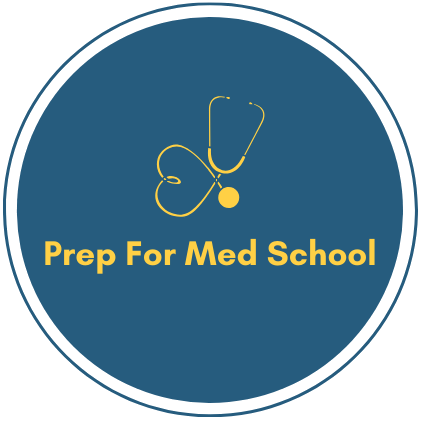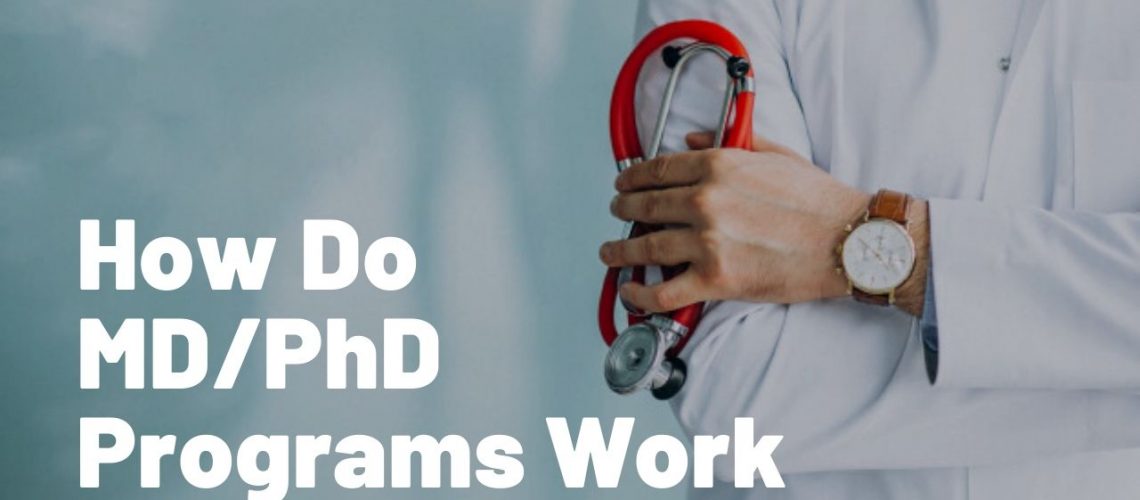MD/PhD programs are intense longitudinal programs that integrate medical and graduate school to train future physician-scientists. These programs are specifically designed for students who are highly motivated to engage in research throughout their careers in medicine.
Table of Contents
Why Choose the MD/PhD Path?
The decision to pursue an MD/PhD should be motivated by a desire to pursue a career that integrates science and medicine. Although MD/PhD programs are not the only route to becoming a physician-scientist, as evidenced by the significant number of physician-scientists who have achieved tremendously successful careers with an MD-only, these programs offer several advantages. In order to fully understand the advantages of an MD/PhD program, it is important to first distinguish medical and graduate school.
Medical School Versus Graduate School
Medical school is primarily focused on producing clinicians who are equipped with the clinical skills to effectively treat patients. Medical students are required to memorize immense and seemingly overwhelming amounts of information and readily apply this knowledge to the patients under their care.
In contrast, graduate school emphasizes critical and creative thinking that can expand upon existing knowledge. Instead of memorizing vast amounts of information, graduate students must learn to conceive novel ideas, overcome hurdles in a challenging project, apply for funding, conduct rigorous statistical analysis, and present their work to the scientific community through publications or presentations. In other words, they must learn how to conduct valid scientific research.
Advantages of the Program
A physician-scientist, regardless of their training route, must undergo both of these learning processes at some point in their career.
This is where MD/PhD programs are truly valuable. Learning medicine and learning science are completely different processes. For the future physician-scientist, the opportunity to learn how to conduct scientific research under the guidance of a qualified mentor and with the support of an administration dedicated to training physician-scientists is the primary advantage of the MD/PhD program over MD-only route.
Longitudinal integration between science and medicine is another strong attribute of MD/PhD programs. As will be discussed later in this article, there is a strong emphasis on integrating clinical medicine with scientific research throughout the duration of the program through opportunities such as journal clubs, case studies, and seminars. This integration also extends to coursework and results in a streamlined time course, so that the combined program takes less time to complete than it would to complete both programs individually. Furthermore, this training occurs in a highly supportive environment where a student is provided protected research time under the guidance of a mentor. Although there are opportunities to conduct research later as an MD-only, these opportunities often do not allow for the same level of time and intensity to focus solely on research.
Finally, with a few rare exceptions, MD/PhD programs offer financial support, stipends, and health insurance. These factors can be valuable for physician scientists as they offset the financial burden from loans as well as the reduced pay incurred from sacrificing clinical duties for research time. From a practical financial perspective, this makes it more feasible for physician-scientists to pursue a career that balances both research and clinical medicine.
The Disadvantage of the Program
Time is the primary disadvantage of pursuing an MD/PhD. The program can take up to 8 years, on average. However, due to unfortunate circumstances, such as failed experiments, conflicts with research mentors, or poor planning, the program can even take longer.
During the graduate phase, students will see the classmates they started medical school with graduate and move onto residency and eventually attending positions, while they continue running experiments in the lab. As mentioned before, physician-scientists often make a financial sacrifice when engaging in research. It is not a path well suited for everyone. It is therefore essential that MD/PhD candidates verify the physician-scientist path is truly worth pursuing.
MD/PhD Application Process
The MD/PhD application process is very similar to the traditional MD applications.
In terms of the AMCAS application, the main difference is that MD/PhD students are required to write two additional essays. One asks students to describe their motivation to pursue an MD/PhD program, while the other asks them to describe their research experiences. Otherwise, it is very similar as students still need to obtain excellent grades, MCAT scores, and letters of recommendations.
In terms of extracurriculars, there is a greater emphasis on research experience. Most accepted students have accumulated a significant amount of research experience by the time they apply. Although publications are helpful, they are not required for admission, especially if the applicant is able to present themselves as someone with the potential to make significant scientific contributions. Students must demonstrate an aptitude and passion for research in their application. Also, they should be able to discuss their research intelligently and acknowledge the challenges that are inherent to a research career. These qualities should also be reflected by the letters written by their research supervisors.
Program Acceptance Rate and Admission Statistics
On average, the GPA and MCAT requirements for MD/PhD programs is higher than that of MD-only students. However, the applicant pool for MD/PhD programs is also far smaller than for regular MD programs.
During the 2019-2020 application cycle, there were 1,813 MD/PhD applicants. Of these, 708 or 39.3% of the applicants successfully matriculated into MD/PhD programs. In comparison, 53,371 applicants applied for MD programs and 21,869 (41%) matriculated into medical school.
The average GPA and MCAT of MD/PhD matriculants compared to the MD program is shown in the table below.
| GPA | MCAT | |
| MD/PhD Matriculants | 3.80 | 516.1 |
| MD Matriculants | 3.73 | 511.5 |
What is the Coursework and Timeline Like
As mentioned earlier, the MD/PhD curriculum is highly integrated in order to train students to interface between science and medicine. A significant number of programs allow students to conduct pre-matriculation rotations the summer before starting medical school. The traditional MD/PhD curriculum is structured so that students complete two years of medical school, move onto graduate school, and after completing it, return to medical school to finish their clinical training.
First Two Years (Medical School)
During the first two years of medical school, MD/PhD students are required to attend events such as journal clubs and seminars that consistently provide them with exposure to science. Following the first two years of medical school, students must take their first US Medical Licensing Exam (STEP 1).
Year 3 to 6 (Graduate School)
Afterward, MD/PhD students will begin their graduate school training. This typically consists of three core steps. First is the qualifying exam, which is an oral and/or written exam that validates a student’s capability to perform rigorous research in the field. The student must then come up with a potential idea, select a committee that will oversee their thesis work, and propose their research project.
Finally, at the end of their graduate program, the student will defend their thesis work in front of their selected committee. Many MD/PhD programs require students to publish a first-author publication before they can return to medical school. Some programs will also require students to engage in clinical activities such as case studies or shadowing during this time to help students maintain their clinical knowledge.
Years 7 and 8 (Return to Medical School)
Upon completing their PhD, the student will return to medical school. Most programs offer a 2-4 week refresher course to help students get up to speed with essentials for medical school. The students will start their third year of medical school, during which they complete their clinical rotations and take their second licensing exam (STEP 2). During the fourth year of medical school, students will apply for residency positions and match in their specialty of choice.
Are MD/PhD and MSTP the Same Thing?
When exploring MD/PhD programs, you may notice that most have a Medical Scientist Training Program (MSTP) designation.
This designation refers to the funding source of the MD/PhD program. MSTP-designated programs are partially funded by NIH institutional training grants. Institutions with the MSTP award typically have an excellent track record of supporting and training MD/PhD students. These programs guarantee funding for tuition remission, health insurance, and stipends throughout the duration of the program.
MSTP programs are often more competitive than non-MSTP MD/PhD programs. However, this does not mean that non-MSTP programs are of poor quality. Several non-MSTP institutions that have excellent residency match records and may even offer graduate programs that are considered more prestigious than some of their MSTP counterparts.
For example, students at the Rutgers Robert Wood Johnson Medical School, a non-MSTP MD/PhD program, can conduct their graduate studies at Princeton University. Furthermore, many of these programs are also fully funded, with the difference being that the institution itself provides the funds without NIH support.
However, there are a few exceptions that applicants should be aware of. Some of these non-MSTP MD/PhD programs do not offer full funding or stipends during part of the training, so students may need to seek alternative sources of funding for these phases.
For example, the Georgetown MD/PhD program provides a scholarship that covers 50% of medical school tuition and fees. Students are also offered a stipend during their summer rotation. During the graduate phase of training, students receive tuition remission and a graduate stipend.
MD/PhD Program Costs and Length
Due to graduate school training, MD/PhD programs are longer than MD-only programs. Typically, the graduate phase lasts 4-4.5 years, although this can vary due to specific focus, project design, mentorship, and luck. In total, the total duration to complete the program is 8 years on average.
All MSTP-funded MD/PhD programs offer tuition waivers, stipends, and health insurance throughout the duration of the program. These benefits are offered by the majority of programs without MSTP designation as well. However, there is some variability and some of these programs may only be partially funded, such as the Georgetown program referenced above.
References:




